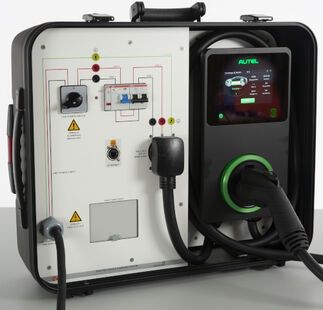MobileTrain "EV Charging Station Trainer, Wallbox, Level 2, 240V"

Benefits of this training system:
- Mobile, compact, and practical, making it easy to transport and set up
- Includes a real practical wall box with a high speed charging 22KW (240V 50 Amp)
power capacity and supply line simulation - Allows for practical commissioning and customer instruction
- Start/stop charging w/RFID Card, or NFC enabled smart watch/phone
- Networking is possible via various interfaces, including Ethernet, RS485, Wi-Fi, and Bluetooth
- Enables actual vehicle charging at a maximum power of 22KW
- Can be integrated into PV systems
- Comes with an integrated fault simulator
The training system has been developed for different training focuses. It consists not only of the Wallbox as a single device, but also includes the installation of the supply line and its safety devices. The training system is very practical and is mainly aimed at the training of electricians. If a charging infrastructure is to be set up, the first thing to be done is to determine or check the location, the max. power demand and also upstream feeders. If necessary, there may also be separate specifications from the energy supplier that must be observed. Then it is decided whether an installation is possible or not. If the installation is to be carried out, the following activities are trained on the training system:
- Protective conductor test (PE/GND) using Fluke 1664
- Insulation resistance measurement L1/L2 - GND using Fluke 1664
- Measurement of the tripping time of the RCD using Fluke 1664
- Measurement of the tripping current of the RCD using Fluke 1664
- Voltage measurement using Fluke 1664
- Loop impedance measurement using Fluke 1664
If the upstream installation or the supply line meets the corresponding requirements (observe country standard), the Wallbox can be plugged in and put into operation.
- Explanations of the technical data on the type plate, or the accompanying documentation
- Commissioning of the Wallbox
- Login and registration
- Determination of communication (Bluetooth, WLAN, LAN, RFID)
- Connecting the Fluke FEV 100 simulator to the charging cable
- Function test Fluke FEV 100:
Status A = No vehicle connected
Status B = Vehicle connected but not ready for charging
Status C = Vehicle connected and ready to charge
Status D = Fan switched on during gassing charging processes
PE Error key = charging process is interrupted GND error
GFCI Test button = RCD test - 4mm safety sockets at the front of the simulator for measuring the CP signal at status A, B, C, D
- Handing over and briefing of the end customer, additional possibilities of the configuration
Dimensions and power supply:
- Power supply: AC 240V, 60Hz (NEMA 6-30P)
- Dimensions: 600 x 320 x 500 mm, 23.6"x12.6"x19.7" (WxHxD)
- Weight: approx. 14 kg, 31 lbs
The test equipment is not included. We recommend Fluke "FEV 100" and Fluke "1664FC US".